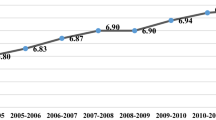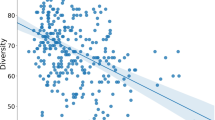Abstract
Using data on German and Swedish multinational enterprises (MNEs), this paper analyzes determinants of location choice and the degree of substitutability of labor across locations. Countries with highly skilled labor strongly attract German but not necessarily Swedish MNEs. In MNEs from either country, affiliate employment tends to substitute for employment at the parent firm. At the margin, substitutability is the strongest with respect to affiliate employment in Western Europe. A one percent larger wage gap between Germany and locations in Central and Eastern Europe (CEE) is associated with 760 fewer jobs at German parents and 4,620 more jobs at affiliates in CEE. A one percent larger wage gap between Sweden and CEE is associated with 140 fewer jobs at Swedish parents and 260 more jobs at affiliates in CEE.
Similar content being viewed by others
References
Anderson, R. G., and J. G. Thursby (1986). Confidence Intervals for Elasticity Estimators in Translog Models. Review of Economics and Statistics 68 (4): 647–656.
Barro, R. J., and J. W. Lee (2001). International Data on Educational Attainment: Updates and Implications. Oxford Economic Papers 53 (3): 541–563.
Becker, S. O., R. Jäckle, and M.-A. Muendler (2005). Kehren deutsche Firmen ihrer Heimat den Rücken? Ausländische Direktinvestitionen deutscher Unternehmen. Ifo Schnelldienst 58 (1): 23–33.
Becker, S. O., K. Ekholm, R. Jäckle, and M.-A. Muendler (2005). Location Choice and Employment Decisions: A Comparison of German and Swedish Multinationals. CESifo Working Paper 1374.
Blomström, M., G. Fors, and R. E. Lipsey (1997). Foreign Direct Investment and Employment: Home Country Experience in the United States and Sweden. Economic Journal 107 (445): 1787–1797.
Braconier, H., and K. Ekholm (2000). Swedish Multinationals and Competition from High- and Low-Wage Locations. Review of International Economics 8 (3): 448–461.
Braconier, H., P.-J. Norbäck, and D. Urban (2002). Vertical FDI Revisited. IUI Working Paper 579. Research Institute of Industrial Economics, Stockholm.
Brainard, S. L. (1997). An Empirical Assessment of the Proximity-Concentration Trade-off between Multinational Sales and Trade. American Economic Review 87 (4): 520–544.
Brainard, S. L., and D. A. Riker (2001). Are U.S. Multinationals Exporting U.S. Jobs? In D. Greenaway and D. R. Nelson (eds.), Globalization and Labour Markets. Cheltenham: Elgar.
Brown, R. S., and L. R. Christensen (1981). Estimates of Elasticities of Substitution in a Model of Partial Static Equilibrium: An Application to US Agriculture, 1947–1974. In E. R. Berndt and B. C. Field (eds.), Modeling and Measuring Natural Resource Substitution. Cambridge, Mass.: MIT Press.
Buch, C. M., J. Kleinert, A. Lipponer, and F. Toubal (2005). Determinants and Effects of Foreign Direct Investment: Evidence from German Firm-Level Data. Economic Policy 41: 51–98.
Burgess, D. F. (1974). A Cost Minimization Approach to Import Demand Equations. Review of Economics and Statistics 56 (2): 225–234.
Carr, D. L., J. R. Markusen, and K. E. Maskus (2003). Estimating the Knowledge-Capital Model of the Multinational Enterprise: Reply. American Economic Review 93 (3): 995–1001.
Christensen, L. R., D. W. Jorgenson, and L. J. Lau (1973). Transcendental Logarithmic Production Frontiers. Review of Economics and Statistics 55 (1): 28–45.
Ekholm, K. (1998). Proximity Advantages, Scale Economies, and the Location of Production. In P. Braunerhjelm and K. Ekholm (eds.), The Geography of Multinational Firms. Boston: Kluwer.
Ekholm, K., and R. Forslid (2001). Trade and Location with Horizontal and Vertical Multi-Region Firms. Scandinavian Journal of Economics 103 (1): 101–118.
Ekholm, K., and M. Hesselman (2000). The Foreign Operations of Swedish Manufacturing Firms: Evidence from a Survey of Swedish Multinationals in 1998. IUI Discussion Paper 540. Research Institute of Industrial Economics, Stockholm.
Feenstra, R. C., and G. H. Hanson (1999). The Impact of Outsourcing and High-Technology Capital on Wages: Estimates for the United States, 1979–1990. Quarterly Journal of Economics 114 (3): 907–940.
Freeman, R. B., and R. H. Oostendorp (2001). The Occupational Wages around the World Data File. International Labour Review 140 (4): 379–401.
Hansson, P. (2001). Skill Upgrading and Production Transfer within Swedish Multinationals in the 1990s. FIEF Working Paper 166. Trade Union Institute for Economic Research, Stockholm.
Head, K., and T. Mayer (2004). Market Potential and the Location of Japanese Investment in the European Union. Review of Economics and Statistics 86 (4): 959–972.
Head, K., and J. Ries (2002). Offshore Production and Skill Upgrading by Japanese Manufacturing Firms. Journal of International Economics 58 (1): 81–105.
ITPS (2004). Svenskägda Koncerner Med Verksamhet I Utlandet 2002. Institutet för tillväxtpolitiska studier 2004. Sveriges Officiella Statistik, 2004:003.
Konings, J., and A. Murphy (2001). Do Multinational Enterprises Substitute Parent Jobs for Foreign Ones? Evidence from European Firm Level Panel Data. CEPR Discussion Paper 2972. Centre for Economic Policy Research, London.
Lipponer, A. (2003). A “New” Micro Database for German FDI. In H. Herrmann and R. Lipsey (eds.), Foreign Direct Investment in the Real and Financial Sector of Industrial Countries. Berlin: Springer.
Marin, D. (2004). A Nation of Poets and Thinkers—Less so with Eastern Enlargement? Austria and Germany. CEPR Discussion Paper 4358. Centre for Economic Policy Research, London.
Markusen, J. R. (2002). Multinational Firms and the Theory of International Trade. Cambridge, Mass.: MIT Press.
Shatz, H. J. (2003). Gravity, Education, and Economic Development in a Multinational Affiliate Location. Journal of International Trade and Economic Development 12 (2): 117–150.
Slaughter, M. J. (1995). Multinational Corporations, Outsourcing, and American Wage Divergence. NBER Working Paper 5253. National Bureau of Economic Research. Cambridge, Mass.
Slaughter, M. J. (2000). Production Transfer within Multinational Enterprises and American Wages. Journal of International Economics 50 (2): 449–472.
Venables, A. J., and H. J. Shatz (2000). The Geography of International Investment. Policy Research Working Paper 2338. World Bank, Washington, D.C.
Author information
Authors and Affiliations
Corresponding author
Additional information
JEL no.
F21, F23, J21, J23
About this article
Cite this article
Becker, S., Ekholm, K., Jäckle, R. et al. Location Choice and Employment Decisions: A Comparison of German and Swedish Multinationals. Rev. World Econ. 141, 693–731 (2005). https://doi.org/10.1007/s10290-005-0052-6
Issue Date:
DOI: https://doi.org/10.1007/s10290-005-0052-6




